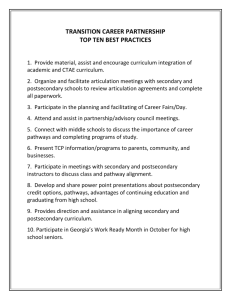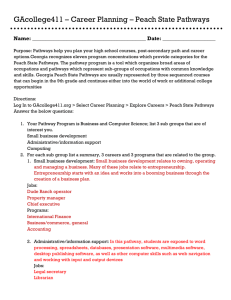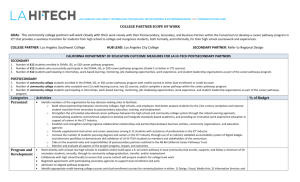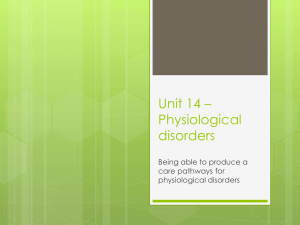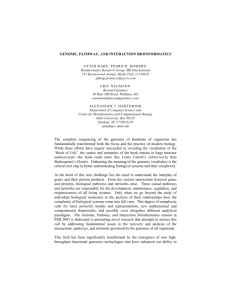Despite the efforts of countless dedicated teachers and
advertisement
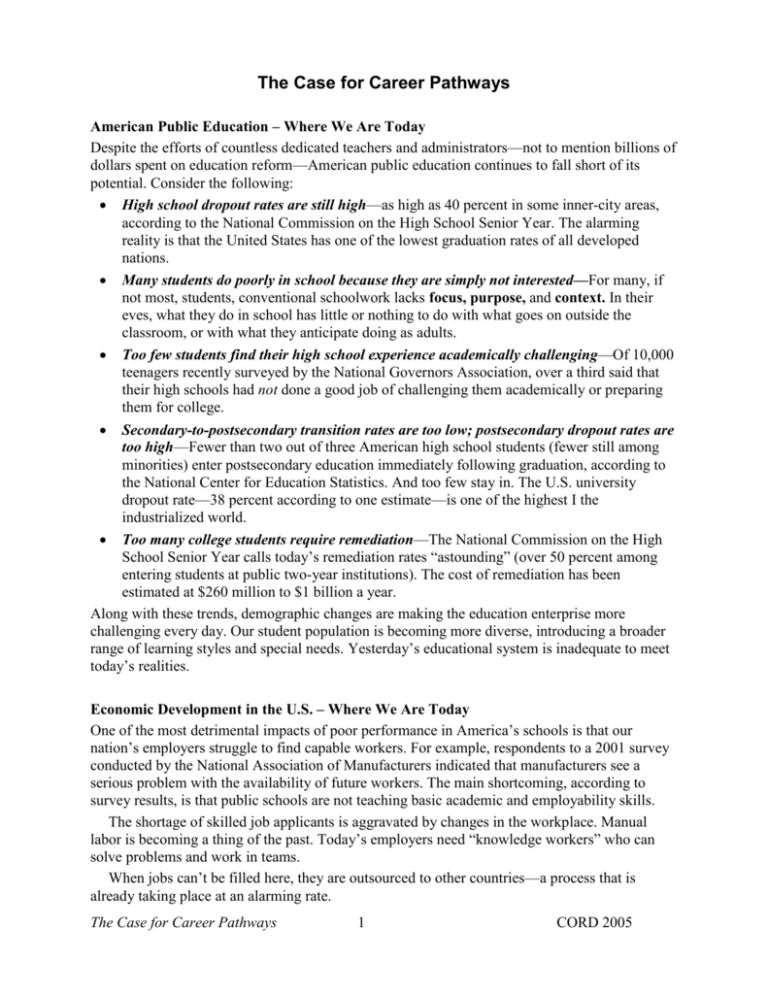
The Case for Career Pathways American Public Education – Where We Are Today Despite the efforts of countless dedicated teachers and administrators—not to mention billions of dollars spent on education reform—American public education continues to fall short of its potential. Consider the following: High school dropout rates are still high—as high as 40 percent in some inner-city areas, according to the National Commission on the High School Senior Year. The alarming reality is that the United States has one of the lowest graduation rates of all developed nations. Many students do poorly in school because they are simply not interested—For many, if not most, students, conventional schoolwork lacks focus, purpose, and context. In their eves, what they do in school has little or nothing to do with what goes on outside the classroom, or with what they anticipate doing as adults. Too few students find their high school experience academically challenging—Of 10,000 teenagers recently surveyed by the National Governors Association, over a third said that their high schools had not done a good job of challenging them academically or preparing them for college. Secondary-to-postsecondary transition rates are too low; postsecondary dropout rates are too high—Fewer than two out of three American high school students (fewer still among minorities) enter postsecondary education immediately following graduation, according to the National Center for Education Statistics. And too few stay in. The U.S. university dropout rate—38 percent according to one estimate—is one of the highest I the industrialized world. Too many college students require remediation—The National Commission on the High School Senior Year calls today’s remediation rates “astounding” (over 50 percent among entering students at public two-year institutions). The cost of remediation has been estimated at $260 million to $1 billion a year. Along with these trends, demographic changes are making the education enterprise more challenging every day. Our student population is becoming more diverse, introducing a broader range of learning styles and special needs. Yesterday’s educational system is inadequate to meet today’s realities. Economic Development in the U.S. – Where We Are Today One of the most detrimental impacts of poor performance in America’s schools is that our nation’s employers struggle to find capable workers. For example, respondents to a 2001 survey conducted by the National Association of Manufacturers indicated that manufacturers see a serious problem with the availability of future workers. The main shortcoming, according to survey results, is that public schools are not teaching basic academic and employability skills. The shortage of skilled job applicants is aggravated by changes in the workplace. Manual labor is becoming a thing of the past. Today’s employers need “knowledge workers” who can solve problems and work in teams. When jobs can’t be filled here, they are outsourced to other countries—a process that is already taking place at an alarming rate. The Case for Career Pathways 1 CORD 2005 Where We Need to Be – If We Hope to Be Globally Competitive The prevailing trends in American public education represent more than numbers; they affect people’s lives and, ultimately, the strength of our nation. American education must take bold steps to redirect those trends toward— High math and reading test scores and college matriculation in career-focused programs— without the need for remediation Close alignment between what students are taught in high school and what they are expected to know when they enroll in postsecondary programs High employment in high-demand fields; upward mobility in the workplace What is a Career Pathway? A Career Pathway is a coherent, articulated sequence of rigorous academic and career/technical courses in an interest area of the student’s choosing. Every Career Pathway begins in the ninth grade and leads to an associate degree, baccalaureate degree (and beyond), an industryrecognized certificate, and/or licensure. The Career Pathway is developed, implemented, and maintained in partnership involving educators (secondary and postsecondary) and employers. Career Pathways are available to all students (including adult learners) and lead to rewarding careers. The essential characteristics of an ideal Career Pathway are the following: 1. The secondary pathway component: Meets state academic standards and grade-level expectations. Meets high school testing and exit requirements. Meets postsecondary (college) entry/placement requirements. Provides foundation knowledge and skills in chosen career clusters. Provides opportunities for students to earn college credit through dual/concurrent enrollment or articulation agreements. 2. The postsecondary pathway component provides: Opportunities for students to earn college credit through dual/concurrent enrollment or articulation agreements. Alignment and articulation with baccalaureate programs. Industry-recognized skills and knowledge in each cluster area. Opportunities for placement in the chosen career clusters at multiple exit points. 3. Pathway partners ensure a culture of empirical evidence is maintained by: Regularly collecting qualitative and quantitative data. Using data for planning and decision-making for continuous pathway improvement. Ongoing dialog among secondary, postsecondary, and business partners. The Power of Career Pathways Career Pathways have the power to make America the undisputed international leader in public education and stem the flow of American jobs to foreign countries. CONTEXT: Career Pathways show students how academic concepts are used outside the classroom. Career Pathways students understand the why of the subjects they study. The Case for Career Pathways 2 CORD 2005 PURPOSE: Career Pathways motivate students and give them the desire to stay in school. With Career Pathways, students take ownership and a sense of pride in their learning. FOCUS (with flexibility): Every Career Pathway leads the student toward personal and professional fulfillment in an interest area of his or her own choosing—while providing the flexibility to change directions at any time. Career Pathways provide a level playing field for students with different learning styles. Career Pathways take into consideration the fact that one size does not fit all. Career Pathways provide guidance for career selection and a foundation for career pursuit. With Career Pathways, students begin their long-term planning early. As a result, every student has a sense of direction. Every course, every concept leads toward an identified goal. Career Pathways use career preparation to provide opportunities for students to learn interdisciplinary problem-solving and critical thinking skills. Career Pathways provide “knowledge workers” who understand systems and can solve problems in teams. Career Pathways provide a foundation for lifelong learning—and lifelong earning. Career Pathways are all about building toward the future, a future in which students can fulfill their potential in the workplace, in their homes, and in their communities. For additional information on Career Pathways see: Career Pathways: Education with a Purpose (ISBN 1-57837-408-1) Authored by Dan Hull and 22 co-authors. The Case for Career Pathways 3 CORD 2005


